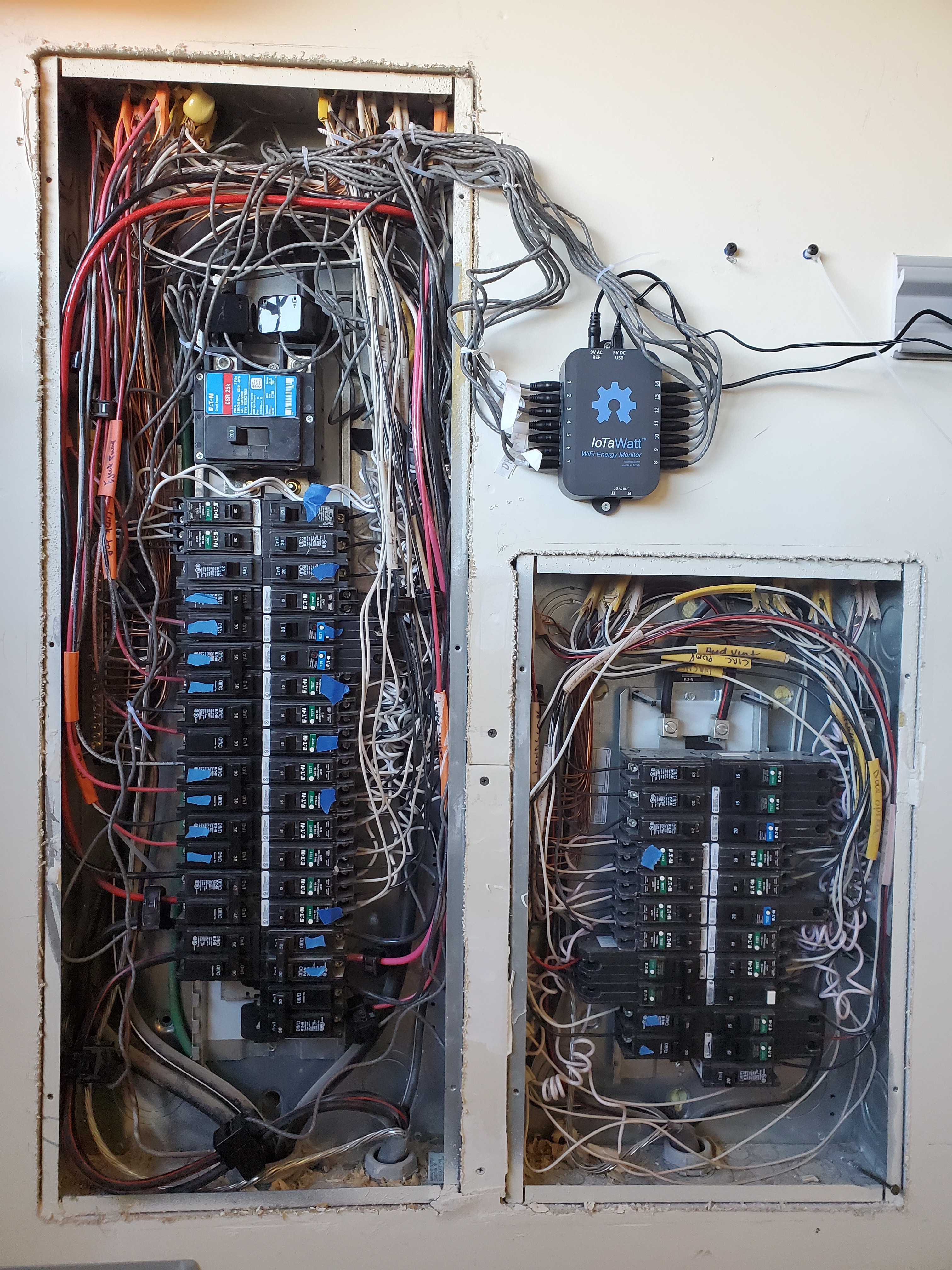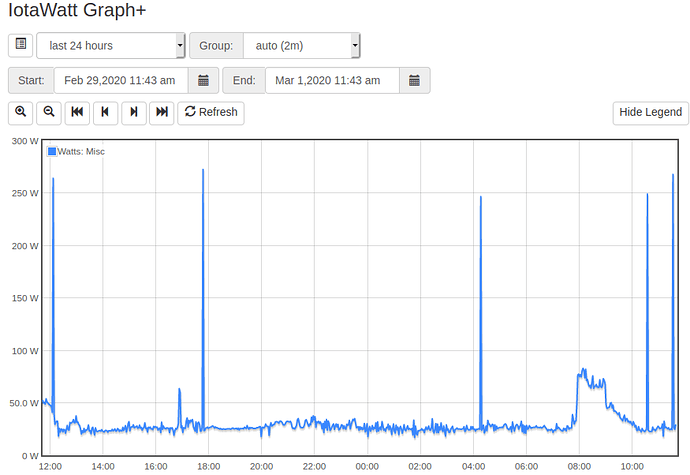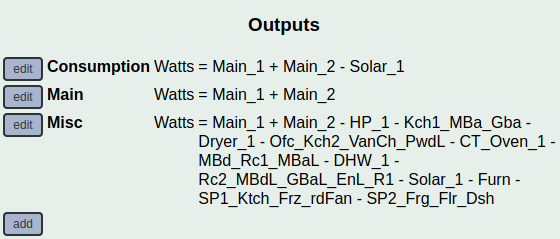I have a full set of 14 CT’s. I have several circuits bundled, and a few of the 220V circuits unmonitored. That left 2 circuits unmonitored. I created a ‘Misc’ output from main1 + main2 - everythingElse. Misc has bias of 25 - 30 W. I’ve turned off breakers, verified that the unmonitored 220V branches are near zero but I can’t figure out where this 27 W is coming from. With neither of those circuits on, and not much going on in the house, its 26.8 W with about +/- 10 W noise. Is this just bias in the sensors?
Not sure what you mean by bias in the sensors. The whole system is not 100% accurate (neither is your meter) but typically calibration issues are proportional to load, not constant. So lets take a look at what you are talking about.
I also have a “misc” category in my home, defined the same way. It is more significant in that it includes some loads that are constant 24/7, like a radon fan, and some transient relatively insignificant loads like the garage door opener.
Here’s what mine looks like:
You can see that it does not really vary significantly with mains load, which indicates to me that it does not have much to do with calibration. If it did, I would see more correlation between the two.
Can you post the same for your installation, over a 24 hour period, and I’ll see what I make of it?
Can you add your mains to that so I can see if there is any relationship?
Boy, that looks pretty clean to me. Can you post the main outputs setup display that has all of the output formulas listed?
Look good to me. It’s amazing that the difference between the aggregate loads and the mains is so consistent, even as the solar drives the mains to multiple kW.
When solar is at 3kW, the misc is less than 1% of the total load, and at night it’s closer to 10% of the total load, yet it doesn’t vary much at all. That’s not a calibration error.
I’m going to stick my neck out and say you have a small 20ish load that is not being measured. Have you tried switching off every breaker that does not have a CT? Are there any CTs with multiple outputs?
If you cannot find it, could you post a high resolution picture of your load center showing as much as possible of the install?
Finally, have you reconciled the mains with the meter? 27 Watts would add up to about .65 kWh/day and would show up in a comparison with the meter after a few days.
EDIT: looking again at your inputs list, I see that you are measuring a lot of 240V appliances with one CT and “double”. I’m pretty sure the HeatPump, Solar and DHW are two wire, but the Dryer, oven and furnace are probably 3 wire (have neutral). The dryer would only cause a problem while running, but the oven and in particular the furnace may have 120V controls that draw continuous power. There is an easy way to test this out. If you move the furnace CT to the other conductor and “reverse” it, the misc calculation will go negative if the furnace is drawing current on that leg only.
If that’s the case, consult the documentation for how to measure a 3 wire load by passing both conductors through the CT in opposite directions instead of doubling one conductor.
I’ve determined that about half of it is the heat pump. I’m just going to assume the rest is a couple of watts here and there on the unmeasured lines and call it good enough. If I get more motivated I might power the Iotawatt and the router off of the inverter in my camper van and power everthing off and do some more testing.
I tried most of the things you suggested before I posted. I’ve switched off the 3 breakers that don’t have a CT, and most of the breakers that do have a CT. Nothing.
Before I doubled the 240V appliances I had 2 CT’s on them and thought it looked pretty good to double them. My record keeping was a little sloppy though. Unfortunately there isn’t any extra wire to loop a wire back and pass both conductors though a CT.
I did some more testing today. My box is really tight so rather than move CT’s I turned off breakers, One by one, I turned off the 240V breakers and observed the Misc drop to around 10-15W with the heat pump off. No change with the dryer, oven, cook top, or furnace, DHW. I did move the solar CT to the other leg, with no observed change in Misc.
Over a 30 day period I compared the iotawatt measurement to the meters, I have a solar meter and a net meter. Over that 30 d period, the solar meter shows 8kWh (1%) more than the iotaWatt. I was barely net positive this month, and both methods were in close agreement. +2 kWh from iotaWatt, +3 from the meter.
Here’s a pic of my breaker box’s, the left one is very tight. The subpanel on the right is measured with CT’s on the conductors going from the main to the sub. I don’t know if that’s code, or my electrician just likes a lot of breakers, but it seems like too many circuits to me.

10-15W isn’t too bad, if that works for you. I can see it varying by that much, but a steady 15W, to me that’s a load, not calibration. The heat-pump is credible if it has a neutral wire and has been running pretty much all the time (like mine this time of year). If any of your other 240V loads have a neutral wire, you could just put a 50A CT on that and see if it’s carrying current.
Yes, you do have a lot of circuits. It is crowded, and I can see how it’s difficult to reverse one wire. On the top left, where there is a stack of 4 30A 240 breakers, moving the top one down by extending the leads and then the three below it up would make it possible to pass both wires through the CT where needed in a three-wire circuit.
The branch panel feeds cross at the top of the panel before they connect to the buss. I think an ECS25200 clamp type CT would fit there and measure both legs, freeing up another input. (The store is out of them, but I have a few kicking around).
I measure my “grid” just outside the meter whereas I have a “house” measurement on the main switch. There is always ~20W difference so I’m assuming that the meter needs a few watts to drive it. The meter is a late model electronic so it must have an internal power supply. I wonder if I’m paying for the power to drive the meter? 20W isn’t exactly expensive. ~500W/h / day so (about 10c / day at my local rates).
I’m going to try to verifying this - I’ll have to switch off everything in the house except the circuit that powers the IotaWatt.
LOL - just had a go and the difference is related to different CT models. Just swapped in the same model CTs and difference is ±3W - aka nothing. Nothing to see here.




